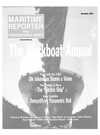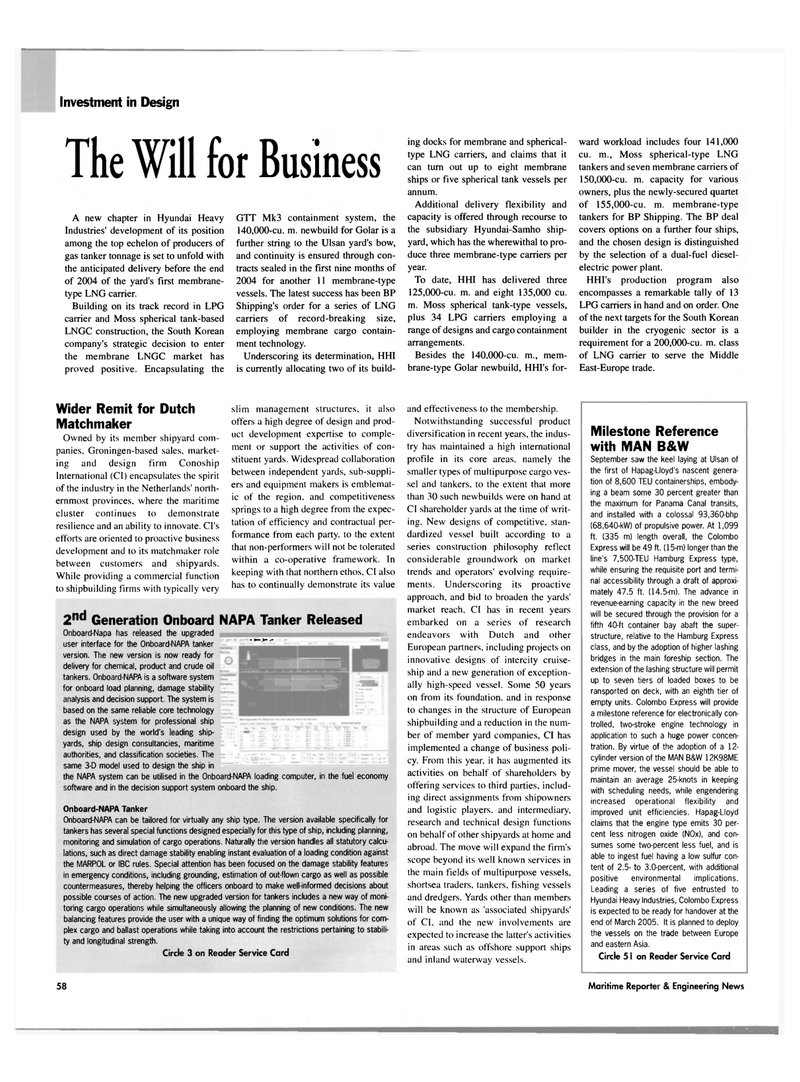
Page 58: of Maritime Reporter Magazine (November 2004)
The Workboat Annual
Read this page in Pdf, Flash or Html5 edition of November 2004 Maritime Reporter Magazine
Investment in Design
The Will for Business
A new chapter in Hyundai Heavy
Industries' development of its position among the top echelon of producers of gas tanker tonnage is set to unfold with the anticipated delivery before the end of 2004 of the yard's first membrane- type LNG carrier.
Building on its track record in LPG carrier and Moss spherical tank-based
LNGC construction, the South Korean company's strategic decision to enter the membrane LNGC market has proved positive. Encapsulating the
GTT Mk3 containment system, the 140,000-cu. m. newbuild for Golar is a further string to the Ulsan yard's bow, and continuity is ensured through con- tracts sealed in the first nine months of 2004 for another 11 membrane-type vessels. The latest success has been BP
Shipping's order for a series of LNG carriers of record-breaking size, employing membrane cargo contain- ment technology.
Underscoring its determination, HHI is currently allocating two of its build- ing docks for membrane and spherical- type LNG carriers, and claims that it can turn out up to eight membrane ships or five spherical tank vessels per annum.
Additional delivery flexibility and capacity is offered through recourse to the subsidiary Hyundai-Samho ship- yard, which has the wherewithal to pro- duce three membrane-type carriers per year.
To date, HHI has delivered three 125,000-cu. m. and eight 135,000 cu. m. Moss spherical tank-type vessels, plus 34 LPG carriers employing a range of designs and cargo containment arrangements.
Besides the 140,000-cu. m., mem- brane-type Golar newbuild, HHI's for- ward workload includes four 141,000 cu. m., Moss spherical-type LNG tankers and seven membrane carriers of 150,000-cu. m. capacity for various owners, plus the newly-secured quartet of 155,000-cu. m. membrane-type tankers for BP Shipping. The BP deal covers options on a further four ships, and the chosen design is distinguished by the selection of a dual-fuel diesel- electric power plant.
HHI's production program also encompasses a remarkable tally of 13
LPG carriers in hand and on order. One of the next targets for the South Korean builder in the cryogenic sector is a requirement for a 200,000-cu. m. class of LNG carrier to serve the Middle
East-Europe trade.
Wider Remit for Dutch
Matchmaker
Owned by its member shipyard com- panies, Groningen-based sales, market- ing and design firm Conoship
International (CI) encapsulates the spirit of the industry in the Netherlands' north- ernmost provinces, where the maritime cluster continues to demonstrate resilience and an ability to innovate. CI's efforts are oriented to proactive business development and to its matchmaker role between customers and shipyards.
While providing a commercial function to shipbuilding firms with typically very slim management structures, it also offers a high degree of design and prod- uct development expertise to comple- ment or support the activities of con- stituent yards. Widespread collaboration between independent yards, sub-suppli- ers and equipment makers is emblemat- ic of the region, and competitiveness springs to a high degree from the expec- tation of efficiency and contractual per- formance from each party, to the extent that non-performers will not be tolerated within a co-operative framework. In keeping with that northern ethos, CI also has to continually demonstrate its value 2nd Generation Onboard NAPA Tanker Released . >— v. ..
Onboard-Napa has released the upgraded user interface for the Onboard-NAPA tanker version. The new version is now ready for delivery for chemical, product and crude oil tankers. Onboard-NAPA is a software system for onboard load planning, damage stability analysis and decision support. The system is based on the same reliable core technology as the NAPA system for professional ship design used by the world's leading ship- yards, ship design consultancies, maritime authorities, and classification societies. The same 3-D model used to design the ship in the NAPA system can be utilised in the Onboard-NAPA loading computer, software and in the decision support system onboard the ship. in the fuel economy
Onboard-NAPA Tanker
Onboard-NAPA can be tailored for virtually any ship type. The version available specifically for tankers has several special functions designed especially for this type of ship, including planning, monitoring and simulation of cargo operations. Naturally the version handles all statutory calcu- lations, such as direct damage stability enabling instant evaluation of a loading condition against the MARP0L or IBC rules. Special attention has been focused on the damage stability features in emergency conditions, including grounding, estimation of out-flown cargo as well as possible countermeasures, thereby helping the officers onboard to make well-informed decisions about possible courses of action. The new upgraded version for tankers includes a new way of moni- toring cargo operations while simultaneously allowing the planning of new conditions. The new balancing features provide the user with a unique way of finding the optimum solutions for com- plex cargo and ballast operations while taking into account the restrictions pertaining to stabili- ty and longitudinal strength.
Circle 3 on Reader Service Card and effectiveness to the membership.
Notwithstanding successful product diversification in recent years, the indus- try has maintained a high international profile in its core areas, namely the smaller types of multipurpose cargo ves- sel and tankers, to the extent that more than 30 such newbuilds were on hand at
CI shareholder yards at the time of writ- ing. New designs of competitive, stan- dardized vessel built according to a series construction philosophy reflect considerable groundwork on market trends and operators' evolving require- ments. Underscoring its proactive approach, and bid to broaden the yards' market reach. CI has in recent years embarked on a series of research endeavors with Dutch and other
European partners, including projects on innovative designs of intercity cruise- ship and a new generation of exception- ally high-speed vessel. Some 50 years on from its foundation, and in response to changes in the structure of European shipbuilding and a reduction in the num- ber of member yard companies, CI has implemented a change of business poli- cy. From this year, it has augmented its activities on behalf of shareholders by offering services to third parties, includ- ing direct assignments from shipowners and logistic players, and intermediary, research and technical design functions on behalf of other shipyards at home and abroad. The move will expand the firm's scope beyond its well known services in the main fields of multipurpose vessels, shortsea traders, tankers, fishing vessels and dredgers. Yards other than members will be known as 'associated shipyards' of CI, and the new involvements are expected to increase the latter's activities in areas such as offshore support ships and inland waterway vessels.
Milestone Reference with MAN B&W
September saw the keel laying at Ulsan of the first of Hapag-Lloyd's nascent genera- tion of 8,600 TEU containerships, embody- ing a beam some 30 percent greater than the maximum for Panama Canal transits, and installed with a colossal 93,360-bhp (68,640-kW) of propulsive power. At 1,099 ft. (335 m) length overall, the Colombo
Express will be 49 ft. (15-m) longer than the line's 7,500-TEU Hamburg Express type, while ensuring the requisite port and termi- nal accessibility through a draft of approxi- mately 47.5 ft. (14.5-m). The advance in revenue-earning capacity in the new breed will be secured through the provision for a fifth 40-ft container bay abaft the super- structure, relative to the Hamburg Express class, and by the adoption of higher lashing bridges in the main foreship section. The extension of the lashing structure will permit up to seven tiers of loaded boxes to be ransported on deck, with an eighth tier of empty units. Colombo Express will provide a milestone reference for electronically con- trolled, two-stroke engine technology in application to such a huge power concen- tration. By virtue of the adoption of a 12- cylinder version of the MAN B&W 12K98ME prime mover, the vessel should be able to maintain an average 25-knots in keeping with scheduling needs, while engendering increased operational flexibility and improved unit efficiencies. Hapag-Lloyd claims that the engine type emits 30 per- cent less nitrogen oxide (NOx), and con- sumes some two-percent less fuel, and is able to ingest fuel having a low sulfur con- tent of 2.5- to 3.0-percent, with additional positive environmental implications.
Leading a series of five entrusted to
Hyundai Heavy Industries, Colombo Express is expected to be ready for handover at the end of March 2005. It is planned to deploy the vessels on the trade between Europe and eastern Asia.
Circle 51 on Reader Service Card 58 Maritime Reporter & Engineering News

 57
57

 3rd Cover
3rd Cover
